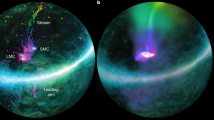Abstract
Part I gives a survey of the drastic revision of cosmic plasma physics which is precipitated by the exploration of the magnetosphere throughin situ measurements. The ‘pseudo-plasma formalism’, which until now has almost completely dominated theoretical astrophysics, must be replaced by an experimentally based approach involving the introduction of a number of neglected plasma phenomena, such as electric double layers, critical velocity, and pinch effect. The general belief that star light is the main ionizer is shown to be doubtful; hydromagnetic conversion of gravitational and kinetic energy may often be much more important.
In Part II the revised plasma physics is applied to dark clouds and star formation. Magnetic fields do not necessarily counteract the contraction of a cloud; they may just as well ‘pinch’ the cloud. Magnetic compression may be the main mechanism for forming interstellar clouds and keeping them together.
Part III treats the formation of stars in a dusty cosmic plasma cloud. Star formation is due to an instability, but it is very unlikely that it has anything to do with the Jeans instability. A reasonable mechanism is that the sedimentation of ‘dust’ (including solid bodies of different size) is triggering off a gravitationally assisted accretion. A ‘stellesimal’ accretion analogous to the planetesimal accretion leads to the formation of a star surrounded by a very low density hollow in the cloud. Matter falling in from the cloud towards the star is the raw material for the formation of planets and satellites.
The study of the evolution of a dark cloud leads to a scenario of planet formation which is reconcilable with the results obtained from studies based on solar system data. This means that the new approach to cosmical plasma physics discussed in Part I logically leads to a consistent picture of the evolution of dark clouds and the formation of solar systems.
Similar content being viewed by others
References
Alfvén, H.: 1958,Tellus 10, 104.
Alfvén, H.: 1963, in J. W. Evans (ed.), ‘The Solar Corona’,IAU Symp. 16, 35.
Alfvén, H.: 1968,Ann. Geophys. 24, 1.
Alfvén, H.: 1975a,Ann. N.Y. Acad. Sci. 257, 179.
Alfvén, H.: 1975b, in B. Hultqvist and L. Stenflo (eds.),Physics of the Hot Plasma in the Magnetosphere, Plenum Press, New York, London, p. 1.
Alfvén, H.: 1977a,Rev. Geophys. Space Phys. 15, 271.
Alfvén, H.: 1977b, Tech. Rep. TRITA-EPP-77-19, Dept of Plasma Phys., Royal Inst. of Tech., Stockholm, Sweden.
Alfvén, H. and Arrhenius, G.: 1976,Evolution of the Solar System, NASA SP-345, Washington D.C.
Belcher, J. W. and Davis, J. R., Jr: 1971,J. Geophys. Res. 76, 3534.
Bennett, W.: 1934,Phys. Rev. 45, 890.
Bergström, J. and Hellsten, T.: 1976,Nuclear Instr. Methods 133, 347.
Block, L. P.: 1972,Cosmic Electrodyn. 3, 349.
Block, L. P.: 1975, in B. Hultqvist and L. Stenflo (eds.),Physics of the Hot Plasma in the Magnetosphere, Plenum Press, New York, London, p. 229.
Block, L. P.: 1976, in D. J. Williams (ed.), ‘Physics of Solar Planet. Environments’,AGU Int. Symp. on Solar-Terr. Physics, Boulder, Colorado, p. 255.
Block, L. P.: 1977, Tech. Rep. TRITA-EPP-77-16, Dept of Plasma Phys., Royal Inst. of Tech., Stockholm, Sweden.
Boström, R.: 1975, Tech. Rep. TRITA-EPP-75-18, Dept of Plasma Phys., Royal Inst. of Tech., Stockholm, Sweden. (Lecture at the Eiscat Summer School, Tromsö, Norway, 8–13 June, 1975.)
Carlqvist, P.: 1969,Solar Phys. 7, 377.
Carlqvist, P.: 1972,Cosmic Electrodyn. 3, 377.
Chapman, S. and Bartels, J.: 1940,Geomagnetism, Vol. II, Clarendon Press, p. 868.
Danielsson, L.: 1973,Astrophys. Space Sci. 24, 459.
de Forest, S. E.: 1972,J. Geophys. Res. 77, 651.
Fälthammar, C.-G.: 1974,Space Sci. Rev. 15, 803.
Fälthammar, C.-G.: 1977,Rev. Geophys. Space Phys. 15, 457.
Heikkila, W. J.: 1972, in E. R. Dyer (ed.), ‘Critical Problems of Magnetospheric Physics’, Symp. Jointly Sponsored by COSPAR, IAGA, and URSI, Madrid, Spain, 11–13 May, 1972, p. 67.
Hirschberg, J., Bame, S. J., and Robbins, D. E.: 1972,Solar Phys. 23, 467.
Hollweg, J. V.: 1975,Rev. Geophys. Space Phys. 13, 263.
Horedt, G. P.: 1976,Astrophys. Space Sci. 45, 353.
Langmuir, I. and Mott-Smith, H., Jr: 1924,Gen. Elec. Rev. 27, 762.
Larson, R. B.: 1973,Ann. Rev. Astron. Astrophys. 11, 219.
Lehnert, B., Bergström, J., and Holmberg, S.: 1966,Nuclear Fusion 6, 231.
Murty, G. S.: 1962,Arkiv Fysik 21, 203.
Raadu, M. A.: 1975, Tech. Rep. TRITA-EPP-75-28, Dept of Plasma Phys., Royal Inst. of Tech., Stockholm, Sweden.
Reasoner, D. L., Lennartsson, W., and Chappell, C. R.: 1976, in A. Rosen (ed.),Spacecraft Charging by Magnetospheric Plasmas, American Inst. of Aeronautics and Astronautics, New York, p. 89.
Rishbeth, H. and Garriott, O. K.: 1969,Introduction to Ionospheric Physics, Academic Press, New York, London, p. 1.
Rose, D. J. and Clark, M., Jr: 1961,Plasmas and Controlled Fusion, MIT Press, Cambridge, p. 331.
Rosenberg, R. L. and Coleman, P. J., Jr: 1969,J. Geophys. Res. 74, 5611.
Sherman, J. C.: 1973,Astrophys. Space Sci. 24, 487.
Smith, E. J., Tsurutani, B. T., and Rosenberg, R. L.: 1976,Eos Trans. AGU 57, 997.
Soberman, R. K., Neste, S. L., and Lichtenfeld, K.: 1974,Science 183, 320.
Spitzer, L., Jr: 1968,Diffuse Matter in Space, Interscience Publishers, New York.
Strom, S. E., Strom, K. M., and Grasdalen, G. M.: 1975,Ann. Rev. Astron. Astrophys. 13, 187.
Torvén, S. and Babić, M.: 1976,IEE 4th Int. Conf. on Gas Discharges, Swansea, 7–10 Sept. 1976, Conf. Publ. No 143, p. 323.
Tsytovich, V. N.: 1977,Theory of Turbulent Plasma, Consultants Bureau, New York, p. 1.
von Hoerner, S.: 1968, in Y. Terzian (ed.),Interstellar Ionized Hydrogen, Charlottesville, Virginia, Dec. 1967.
William, I. P. and Crampin, D. J.: 1971,Monthly Notices Roy. Astron. Soc. 152, 261.
Zmuda, A. J. and Armstrong, J. C.: 1974,J. Geophys. Res. 79, 4611.
Author information
Authors and Affiliations
Rights and permissions
About this article
Cite this article
Alfvén, H., Carlqvist, P. Interstellar clouds and the formation of stars. Astrophys Space Sci 55, 487–509 (1978). https://doi.org/10.1007/BF00642272
Received:
Issue Date:
DOI: https://doi.org/10.1007/BF00642272




